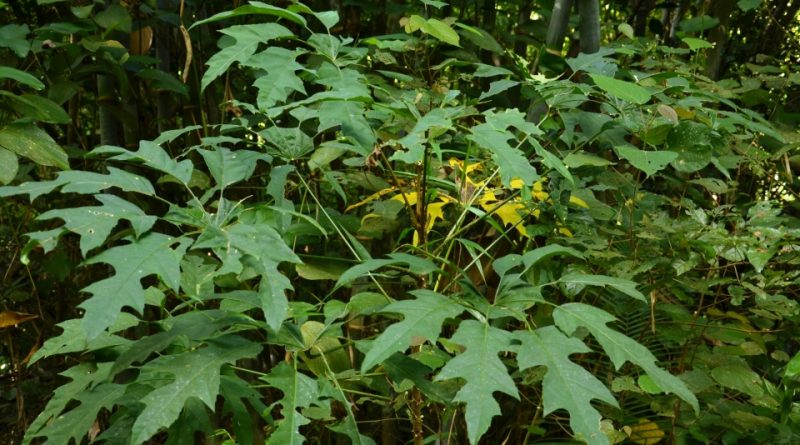Trevesia palmata
Trevesia palmata
The snowflake plant or snowflake aralia (Trevesia palmata (Roxb. ex Lindl.) Vis. 1842) is an arboreal species belonging to the Araliaceae family.
Systematic –
From a systematic point of view it belongs to:
Eukaryota domain,
Kingdom Plantae,
Subkingdom Tracheobionta,
Spermatophyta Superdivision,
Division Magnoliophyta,
Class Magnoliopsida,
Subclass Rosidae,
Order Apiales,
Araliaceae family,
Subfamily Aralioideae,
Trevesia genus,
Species T. palmata.
The term is basionym:
– Gastonia palmata Roxb. ex Lindl..
The terms are synonymous:
– Aralia dubia Spreng.;
– Brassaiopsis confluens Seem.;
– Brassaiopsis papayoides Hand.-Mazz.;
– Fatsia cavaleriei H.Lév.;
– Gilibertia palmata (Roxb. ex Lindl.) DC.;
– Hedera ferruginea Wall.;
– Hedera palmata Wall. ex C.B.Clarke;
– Plerandra jatrophifolia Hance;
– Plerandropsis bonii R.Vig.;
– Trevesia cavaleriei (H.Lév.) Grushv. & Skvortsova;
– Trevesia longipedicellata Grushv. & Skvortsova;
– Trevesia longipedicellata var. palmatipartita Grushv. & Skvortsova;
– Trevesia palmata var. costata H.L.Li;
– Trevesia palmata var. incisa Boerl.;
– Trevesia palmata var. palmata;
– Trevesia sanderi Danhart;
– Trevesia sphaerocarpa Grushv. & Skvortsova.
Within this species, in addition to the nominal one, the following variety is recognised:
– Trevesia palmata var. insignis (Miq.) C.B.Clarke.
Etymology –
The term Trevesia of the genus was dedicated by the author, Roberto de Visiani (1800-1878), in honor of the Treves family of the Bonfili of Padua, patrons of 19th century botany.
The specific epithet palmata comes from the Latin palmatus, i.e. palmate, with obvious reference to the shape of the leaves.
Geographic Distribution and Habitat –
Trevesia palmata is a plant that grows in south-east Asia and is native to an area that includes: the forests of Assam, Bangladesh, Cambodia, Bhutan, India, Laos, Burma, southern China, the eastern Himalayas, the Andaman Islands, Laos, Myanmar, Nepal, Thailand and Vietnam.
Its habitat is that of the undergrowth in humid and mixed forests on the mountain slopes; at altitudes between 600 and 2,000 meters.
Description –
Trevesia palmata is an evergreen plant that grows in the form of a shrub or small tree up to 8 m tall.
Its trunk reaches 15 cm in diameter. The branches are thorny and pubescent.
Its simple leaves, arranged alternately, with long and spiny petioles, are 5-9 lobed, each lobe is strictly ovate-lanceolate, with serrated edges. The entire leaf blade is approximately 60-90 cm wide. Leaf shape varies greatly between individuals as well as within the same plant.
The inflorescences are panicle-like terminals with ramifications bearing one terminal umbel and two almost opposite ones in the median area, 5-10 cm in diameter, with a few dozen scented hermaphroditic yellowish-white flowers of about 12-18 mm in diameter.
The fruits are ovoid in shape, about 2 cm in diameter.
Inside there are 7-12 seeds.
Cultivation –
Trevesia palmata is a shrub or small tree that sometimes forms a coarse and wide crown, other times it is not branched.
The flower buds are collected from the wild and consumed locally. The plant also has useful pith, medicinal properties and is grown as an ornamental.
This plant prefers a partial shade position, growing even in fairly deep shade, although it adapts to full sun and in an area sheltered from the wind.
From a pedological point of view, it grows best in deep, rich and fertile soil and tolerates moist, well-drained, fertile and clayey soils.
It is a very ornamental plant due to the unusual shape of the leaves, which resembles snow crystals, hence some common names. It can be cultivated outdoors in tropical, subtropical and warm temperate areas, where it can withstand temperatures up to around – for a short period. 4°C, also with loss of the aerial part, but revegetating from the base.
In pots it is highly decorative, to be used in spacious environments, and should be grown in porous, draining, slightly acidic substrates, kept humid during the vegetative period, allowing it to partially dry between waterings in winter.
Reproduction can take place by seed, by cuttings of green wood or layering.
Customs and Traditions –
Trevesia palmata is a plant known by various common names, including: snowflake aralia, snowflake plant (English); trevesia palmé, flocon de neige (French); pata-de-ganso, pé-de-pato, arália-pata-de-ganso, arália-pé-de-pato (Portuguese); copo de nieve (Spanish); schneeflockenbaum (German).
It is a plant suitable for cultivation in parks and gardens due to its attractive foliage.
The young leaves and immature inflorescences are consumed boiled by some local populations.
Among other uses, it should be remembered that the pith of the stems can be used to make “sola-pith” hats; it is, however, of lower quality than that obtained from the Aeschynomene aspera plant.
Preparation Method –
Trevesia palmata known for some uses especially in the areas of south-east Asia where it grows in its natural state.
Among the edible uses it is reported that cooked flower buds are consumed.
The plant is also used in traditional local medicine.
Guido Bissanti
Sources
– Acta Plantarum – Flora of the Italian Regions.
– Wikipedia, the free encyclopedia.
– GBIF, the Global Biodiversity Information Facility.
– Useful Tropical Plants Database.
– Conti F., Abbate G., Alessandrini A., Blasi C. (ed.), 2005. An annotated checklist of the Italian vascular flora, Palombi Editore.
– Pignatti S., 1982. Flora d’Italia, Edagricole, Bologna.
– Treben M., 2000. Health from the Lord’s Pharmacy, Advice and experiences with medicinal herbs, Ennsthaler Editore.
Photo source:
– https://inaturalist-open-data.s3.amazonaws.com/photos/42405587/original.jpg
– https://id.digitarium.fi/api/C.450739/Preview001.jpg
Attention: Pharmaceutical applications and food uses are indicated for informational purposes only, they do not represent in any way a medical prescription; we therefore decline any responsibility for their use for healing, aesthetic or food purposes.


